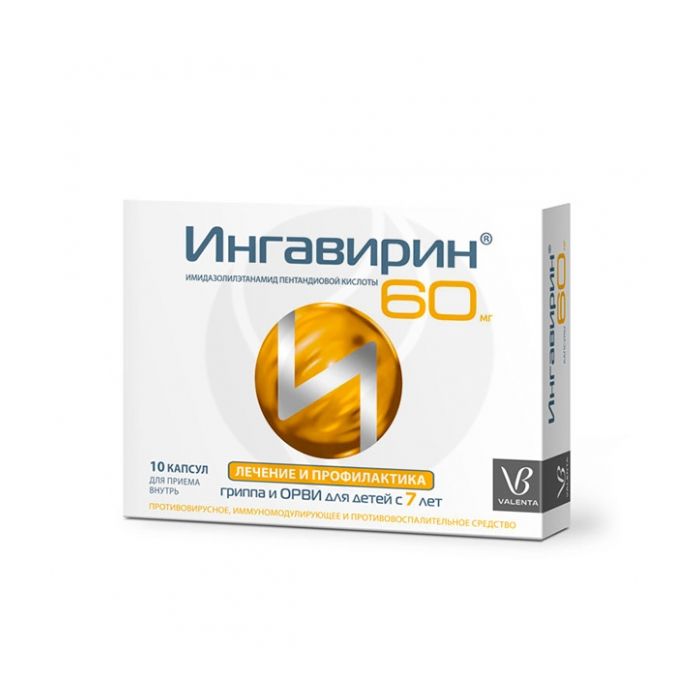Ingavirin capsules 60mg, No. 10
Expiration Date: 11/2025
Russian Pharmacy name:
Ингавирин капсулы 60мг, №10
Inside. Regardless of the meal. For the treatment of influenza and acute respiratory viral infections, children from 7 to 17 years old are prescribed 1 capsule (60 mg) once a day. Duration of treatment is 5-7 days (depending on the severity of the condition). Taking the drug begins from the moment the first symptoms of the disease appear, preferably no later than 2 days from the onset of the disease. For the prevention of influenza and acute respiratory viral infections after contact with sick persons, children from 7 to 17 years old are prescribed 1 capsule (60 mg) once a day for 7 days
One capsule contains:
active substance:
Imidazolylethanamide of pentanedioic acid (vitaglutam) in terms of 100% substance - 60.00 mg;
excipients: lactose monohydrate, potato starch, colloidal silicon dioxide (aerosil), magnesium stearate; hard gelatin capsules: titanium dioxide E 171, iron dye yellow oxide E 172, gelatin; composition of ink for the logo: shellac, propylene glycol E 1520, titanium dioxide E 171.
Hypersensitivity to the active substance or any other component of the drug.
Lactase deficiency, lactose intolerance, glucose-galactose malabsorption.
Pregnancy.
Breastfeeding period.
Children under 7 years of age. This dosage form is not intended for use in persons 18 years of age and older (it is necessary to use dosage forms that provide the possibility of taking IngavirinЃ at a dose of 90 mg).
pharmachologic effect
Antiviral drug.
Preclinical and clinical studies have shown efficacy against type A influenza viruses (A / H1N1, including 'swine' A / H1N1 pdm09, A / H3N2), A / H5N1)) and type B, adenovirus, parainfluenza virus, respiratory syncytial virus; in preclinical studies: coronavirus, metapneumovirus, enteroviruses, incl. Coxsackie virus and rhinovirus.
Promotes accelerated elimination of viruses, shortening the duration of the disease, and reducing the risk of complications.
The mechanism of action is realized at the level of infected cells by stimulating factors of innate immunity, suppressed by viral proteins. Experimental studies, in particular, have shown that IngavirinЃ increases the expression of the first type of interferon IFNAR receptor on the surface of epithelial and immunocompetent cells. An increase in the density of interferon receptors leads to an increase in the sensitivity of cells to signals from endogenous interferon. The process is accompanied by the activation (phosphorylation) of the STAT1 transmitter protein, which transmits a signal to the cell nucleus for the induction of antiviral genes. It has been shown that under conditions of infection, the drug stimulates the production of the antiviral effector protein MxA, which inhibits the intracellular transport of ribonucleoproteins of various viruses, slowing down the process of viral replication.
The drug causes an increase in the content of interferon in the blood to a physiological norm, stimulates and normalizes the reduced? -Interferon-producing ability of blood leukocytes, stimulates? -Interferon-producing ability of leukocytes. It causes the generation of cytotoxic lymphocytes and increases the content of NK-T cells, which have a high killer activity in relation to cells infected with viruses.
The anti-inflammatory effect is due to the suppression of the production of key pro-inflammatory cytokines (tumor necrosis factor (TNF-?), interleukins (IL-1? and IL-6)), a decrease in the activity of myeloperoxidase.
Experimental studies have shown that combined use with antibiotics increases the effectiveness of therapy on the model of bacterial sepsis, incl. caused by penicillin-resistant strains of staphylococcus.
Experimental toxicological studies carried out indicate a low level of toxicity and a high safety profile of this active substance.
Pharmacokinetics
When used in recommended doses, the determination of the active substance in blood plasma by available methods is not possible.
In experimental studies using a radioactive label, it was found that the drug quickly enters the bloodstream from the gastrointestinal tract and is evenly distributed throughout the internal organs.
Cmax in blood, blood plasma and most organs is reached 30 minutes after drug administration. The values ??of the AUC of the kidneys, liver and lungs slightly exceed the AUC of the blood (43.77 ?g ? h / g). The AUC values ??of the spleen, adrenal glands, lymph nodes and thymus are below the AUC of blood. The average retention time of the drug in the blood is 37.2 hours.
With a course intake 1 time / day, the active substance accumulates in the internal organs and tissues. At the same time, the qualitative characteristics of the pharmacokinetic curves after each administration of the drug were identical: a rapid increase in the concentration of the drug after each administration 0.5-1 h after administration and then a slow decrease by 24 h.
It is not metabolized in the body and is excreted unchanged.
The main process of excretion occurs within 24 hours. During this time, 80% of the dose taken is excreted. During the first 5 hours, 34.8% is withdrawn, in the following hours - 45.2%. Of these, 77% are excreted through the intestines, 23% by the kidneys.
Side effect
Rarely: allergic reactions.
Application during pregnancy and lactation
Use during pregnancy and lactation (breastfeeding) is contraindicated.
Application in children
Contraindicated in children of different ages, depending on the dosage form used.
special instructions
According to the parameters of acute toxicity, this active substance belongs to the 4th class of toxicity - 'Low-toxic substances' (when determining the LD50 in experiments on acute toxicity, lethal doses of the drug cannot be determined).
Drug interactions
Concomitant use of other antiviral drugs is not recommended.

